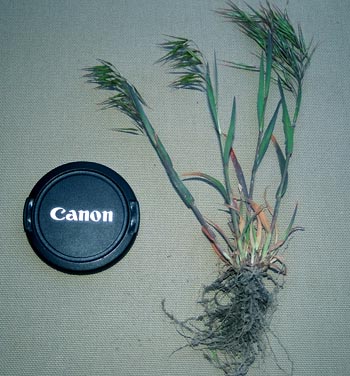Cheatgrass

Common Name(s):
Cheatgrass
Downy Brome
June Grass
Scientific Name:
Bromus tectorum L.
Scientific Name Synonyms:
None known
Symbol:
BRTE
Description:
Life Span: Winter annual
Origin: Introduced
Season: Cool
Growth Characteristics: A weedy annual grass, 2 inches to 2 feet tall. Has a branched base and is typically rusty-red to purple at maturity. Seeds germinate in the late fall or early spring. Has rapid spring growth, with seeds maturing within 2 months of beginning growth. Reproduces from seeds. An aggressive weed.
Seedhead: Open, drooping, much branched panicle; spikelets contain 5 to 8 florets; glumes and lemmas pubescent or downy; lemmas narrow with awns 5/8 inch long or longer.
Leaves: Pubescent blades and sheaths; blades flat, 1/8 inch to ¼ inch wide; leaves rolled in the bud; ligules 1/16 to 1/8 inch long, membranous, rounded to collar shaped, with long pointed teeth; auricles absent.
Ecological Adaptions:
Cheatgrass is widely adapted. It grows on all exposures and all types of topography from desert valley bottoms to the tops of the highest mountain peaks, 2,500 to 13,000 feet in elevation. It invades heavily grazed rangeland, roadsides, waste places, burned areas, and disturbed sites quickly.
Soils: It is adapted to all kind of soils except the extremely wet or extremely saline alkali and thrives where there is only weak competition from perennial native or introduced plants.
Associated Species: Cheatgrass is an invader plant in all Utah range sites, and is therefore associated with hundreds of other plant species.
Uses and Management:
Forage quality and yields vary drastically. It has a very short growing period during which the forage varies from poor to fair. It is fair to good for livestock before the inflorescence emerges, then has little value, except for watershed protection. Seedheads have awns that may injure eyes and mouth of grazing animals and contaminate fleece. Deer and pronghorn graze it in the spring while it is actively growing. It furnishes some food for upland birds and rodents. Chukars as well as partridges are uniquely adapted to cheatgrass infested range where it provides food and cover. Canada geese also use it heavily for feed in the fall immediately after it germinates. Seed is also used by mourning dove and other upland game birds.
Management should be aimed at replacing cheatgrass with a perennial plant cover. This involves releasing grazing pressure during the flower and seed formation stages of the desirable plants. Fire return intervals should also be lengthened to help perennial vegetation recover. The best management has been to ensure perennial herbaceous plants are managed to dominate the site. Avoid burns, especially in the spring and summer periods, when explosive cheatgrass fires are most dangerous to life and property and injurious to the perennial plants.

